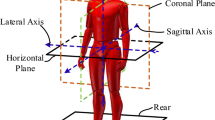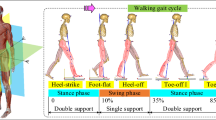Abstract
Existing microprocessor-controlled passive prosthetic knees (PaPKs) and active prosthetic knees (AcPKs) cannot truly simulate the muscle activity characteristics of the active–passive hybrid action of the knee during the normal gait. Differences in EMG between normal and different prosthetic gait for different phases were never separately analyzed. In this study, a novel hybrid active–passive prosthetic knee (HAPK) is proposed and if and how muscle activity and kinematics changes in different prosthetic gait are analyzed. The hybrid hydraulic-motor actuator is adopted to fully integrate the advantages of hydraulic compliance damping and motor efficiency, and the hierarchical control strategy is adopted to realize the adaptive predictive control of the HAPK. The kinematic data and EMG data of normal gait and different prosthetic gait were compared by experiments, so as to analyze the changes in the muscle activity and spatio-temporal data per phase compared to normal walking and the adaptations of amputees when walking with a different kind of prosthesis (the mechanical prosthesis (MePK), the PaPK and the HAPK). The results show that changes in prosthetic gait mainly consisted of decreased self-selected walking speed, gait symmetry and maximum knee flexion, increased first double support phase duration, muscle activation in both opposed and prosthetic limb and inter-subject variability. The differences between controls and MePK, PaPK and HAPK decreases sequentially. These results indicate that the hybrid active–passive actuating mode can have positive effects on improving the approximation of healthy gait characteristics.















Similar content being viewed by others
Data availability
The datasets analyzed during the current study are available from the corresponding author on reasonable request.
References
Low, E. E., Inkellis, E., & Morshed, S. (2017). Complications and revision amputation following trauma-related lower limb loss. Injury, 48(2), 364–370.
Kowal, M., Winiarski, S., Gieysztor, E., Kołcz, A., Walewicz, K., Borowicz, W., Rutkowska-Kucharska, A., & Paprocka-Borowicz, M. (2021). Symmetry function in gait pattern analysis in patients after unilateral transfemoral amputation using a mechanical or microprocessor prosthetic knee. Journal of NeuroEngineering and Rehabilitation, 18, 9.
Price, M. A., Beckerle, P., & Sup, F. C. (2019). Design optimization in lower limb prostheses: A review. IEEE Transactions on Neural Systems and Rehabilitation Engineering, 27(8), 1574–1588.
Cao, W. J., Chen, C. J., Wang, D. S., Wu, X. Y., Chen, L. X., Xu, T. T., & Liu, J. S. (2021). A lower limb exoskeleton with rigid and soft structure for loaded walking assistance. IEEE Robotics and Automation Letters, 7(1), 454–461.
Long, Y., & Peng, Y. J. (2022). Design and control of a quasi-direct drive actuated knee exoskeleton. Journal of Bionic Engineering, 19, 678–687.
Torrealba, R. R., & Fonseca-Rojas, E. D. (2019). Toward the development of knee prostheses: Review of current active devices. Applied Mechanics Reviews, 71(3), 030801.
Mileusnic, M. P., Rettinger, L., Highsmith, M. J., & Hahn, A. (2021). Benefits of the Genium microprocessor controlled prosthetic knee on ambulation, mobility, activities of daily living and quality of life: A systematic literature review. Disability and Rehabilitation: Assistive Technology, 16(5), 453–464.
Johansson, J. L., Sherrill, D. M., Riley, P. O., Bonato, P., & Herr, H. (2005). A clinical comparison of variable-damping and mechanically passive prosthetic knee devices. American Journal of Physical Medicine & Rehabilitation, 84(8), 563–575.
Chin, T., Machida, K., Sawamura, S., Shiba, R., Oyabu, H., Nagakura, Y., Takase, I., & Nakagawa, A. (2006). Comparison of different microprocessor controlled knee joints on the energy consumption during walking in trans-femoral amputees: Intelligent knee prosthesis (IP) versus C-leg. Prosthetics and Orthotics International, 30(1), 73–80.
Wang, X. M., Meng, Q. L., & Yu, H. L. (2021). Design and preliminary testing of a novel variable-damping prosthetic knee. IETE Journal of Research. https://doi.org/10.1080/03772063.2021.2012279
Seid, S., Chandramohan, S., & Sujatha, S. (2018). Optimal design of an MR damper valve for prosthetic knee application. Journal of Mechanical Science and Technology, 32, 2959–2965.
Bonnet, X., Pillet, H., Fodé, P., Lavaste, F., & Skalli, W. (2009). Gait analysis of a transfemoral amputee with a hydraulic polycentric knee prosthesis. Computer Methods in Biomechanics and Biomedical Engineering, 12(S1), 59–60.
Ekkachai, K., & Nilkhamhang, I. (2016). Swing phase control of semi-active prosthetic knee using neural network predictive control with particle swarm optimization. IEEE Transactions on Neural Systems and Rehabilitation Engineering, 24(11), 1169–1178.
Wolf, E. J., Everding, V. Q., Linberg, A. A., Czerniecki, J. M., & Gambel, C. J. M. (2013). Comparison of the Power Knee and C-Leg during step-up and sit-to-stand tasks. Gait & Posture, 38(3), 397–402.
Elery, T., Rezazadeh, S., Nesler, C., & Gregg, R. D. (2020). Design and validation of a powered knee–ankle prosthesis with high-torque, low-impedance actuators. IEEE Transactions on Robotics, 36(6), 1649–1668.
Quintero, D., Villarreal, D. J., Lambert, D. J., Kapp, S., & Gregg, R. D. (2018). Continuous-phase control of a powered knee–ankle prosthesis: Amputee experiments across speeds and inclines. IEEE Transactions on Robotics, 34(3), 686–701.
Geeroms, J., Flynn, L., Jimenez-Fabian, R., Vanderborght, B., & Lefeber, D. (2017). Design and energetic evaluation of a prosthetic knee joint actuator with a lockable parallel spring. Bioinspiration & Biomimetics, 12(2), 026002.
Best, T. K., Embry, K. R., Rouse, E. J., & Gregg, R. D. (2021). Phase-variable control of a powered knee-ankle prosthesis over continuously varying speeds and inclines. In: 2021 IEEE/RSJ International Conference on Intelligent Robots and Systems (IROS), Prague, Czech Republic, pp. 6182–6189.
Ahn, H. J., Lee, K. H., & Lee, C. H. (2017). Design optimization of a knee joint for an active transfemoral prosthesis for weight reduction. Journal of Mechanical Science and Technology, 31(12), 5905–5913.
Martinez-Villalpando, E. C., Mooney, L., Elliott, G., & Herr, H. (2011). Antagonistic active knee prosthesis. A metabolic cost of walking comparison with a variable-damping prosthetic knee. In: 2011 Annual International Conference of the IEEE Engineering in Medicine and Biology Society, Boston, USA, pp. 8519–8522.
Zhang, K. G., Luo, J. W., Xiao, W. T., Zhang, W., Liu, H. Y., Zhu, J. L., Lu, Z. Y., Rong, Y. M., Silva, C. W., & Fu, C. L. (2020). A subvision system for enhancing the environmental adaptability of the powered transfemoral prosthesis. IEEE Transactions on Cybernetics, 51(6), 3285–3297.
Sun, Y. X., Tang, P., Dong, D. B., Zheng, J., Chen, X. H., & Bai, L. (2021). Modeling and experimental evaluation of a pneumatic variable stiffness actuator. Advance online Publication. https://doi.org/10.1109/TMECH.2021.3116871
Sun, Y. X., Tang, H., Tang, Y. T., Zheng, J., Dong, D. B., Chen, X. H., Liu, F. Q., Bai, L., Ge, W. J., Xin, L. M., Pu, H. Y., Peng, Y., & Luo, J. (2021). Review of recent progress in robotic knee prosthesis related techniques: Structure, actuation and control. Journal of Bionic Engineering, 18(4), 764–785.
Andrade, R. M., Antônio Filho, B., Vimieiro, C. B., & Pinotti, M. (2019). Evaluating energy consumption of an active magnetorheological knee prosthesis. In: 19th International Conference on Advanced Robotics (ICAR), Belo Horizonte, Brazil, pp. 75–80.
Andrade, R. M., Martins, J. S. R., Pinotti, M., Filho, A. B., & Vimieiro, C. B. S. (2021). Novel active magnetorheological knee prosthesis presents low energy consumption during ground walking. Journal of Intelligent Material Systems and Structures, 32(14), 1591–1603.
Jaegers, S. M., Arendzen, J. H., & de Jongh, H. J. (1995). Prosthetic gait of unilateral transfemoral amputees: A kinematic study. Archives of Physical Medicine and Rehabilitation, 76(8), 736–743.
Vrieling, A. H., Van Keeken, H. G., Schoppen, T., Hof, A. L., Otten, B., Halbertsma, J. P., & Postema, K. (2009). Gait adjustments in obstacle crossing, gait initiation and gait termination after a recent lower limb amputation. Clinical Rehabilitation, 23(7), 659–671.
Jaegers, S. M., Arendzen, J. H., & de Jongh, H. J. (1996). An electromyographic study of the hip muscles of transfemoral amputees in walking. Clinical Orthopaedics and Related Research, 328, 119–128.
Seroussi, R. E., Gitter, A., Czerniecki, J. M., & Weaver, K. (1996). Mechanical work adaptations of above-knee amputee ambulation. Archives of Physical Medicine and Rehabilitation, 77(11), 1209–1214.
Wentink, E. C., Prinsen, E. C., Rietman, J. S., & Veltink, P. H. (2013). Comparison of muscle activity patterns of transfemoral amputees and control subjects during walking. Journal of Neuroengineering and Rehabilitation, 10, 87.
Prinsen, E. C., Nederhand, M. J., & Rietman, J. S. (2011). Adaptation strategies of the lower extremities of patients with a transtibial or transfemoral amputation during level walking: A systematic review. Archives of Physical Medicine and Rehabilitation, 92(8), 1311–1325.
Bae, T. S., Choi, K., & Mun, M. (2009). Level walking and stair climbing gait in above-knee amputees. Journal of Medical Engineering & Technology, 33(2), 130–135.
Wang, X. M., Meng, Q. L., Zhang, Z. W., Sun, J. Y., Yang, J., & Yu, H. L. (2020). Design and evaluation of a hybrid passive–active knee prosthesis on energy consumption. Mechanical Sciences, 11(2), 425–436.
Cao, W. J., Yu, H. L., Chen, W. M., Meng, Q. L., & Chen, C. J. (2019). Design and evaluation of a novel microprocessor-controlled prosthetic knee. IEEE Access, 7, 178553–178562.
Błażkiewicz, M. I. C. H. A. L. I. N. A., Wiszomirska, I., & Wit, A. (2014). Comparison of four methods of calculating the symmetry of spatial-temporal parameters of gait. Acta of Bioengineering and Biomechanics, 16(1), 29–35.
Mickelborough, J., Van Der Linden, M. L., Tallis, R. C., & Ennos, A. R. (2004). Muscle activity during gait initiation in normal elderly people. Gait & Posture, 19(1), 50–57.
Granata, K. P., Padua, D. A., & Abel, M. F. (2005). Repeatability of surface EMG during gait in children. Gait & Posture, 22(4), 346–350.
Burden, A. M., Trew, M., & Baltzopoulos, V. (2003). Normalisation of gait EMGs: A re-examination. Journal of Electromyography and Kinesiology, 13(6), 519–532.
Merletti, R., Rainoldi, A., & Farina, D. (2004). Factors affecting surface EMG variables. In R. Merletti & P. Parker (Eds.), Electromyography: Physiology, engineering, and non-invasive applications (pp. 246–251). Wiley.
Acknowledgements
This work was supported in part by the National Natural Science Foundation of China under Grant 62073224, the National Key Research and Development Program of China under Grant 2018YFB1307303, and the program of China Scholarships Council under Grant 202108310200. The authors would also like to thank Changlong Chen and Zhewen Zhang for constructive discussions on the project, and Jie Sun and Linrong Li for their contributions in experiments.
Author information
Authors and Affiliations
Contributions
XW and QM conceived of the presented idea and developed the theory. XW carried out the implementation. XW, SB, and QM wrote the manusript with input from all authors. HY was in charge of overall direction and planning.
Corresponding author
Ethics declarations
Conflict of interest
The authors declare that they have no conflict of interest.
Rights and permissions
Springer Nature or its licensor holds exclusive rights to this article under a publishing agreement with the author(s) or other rightsholder(s); author self-archiving of the accepted manuscript version of this article is solely governed by the terms of such publishing agreement and applicable law.
About this article
Cite this article
Wang, X., Meng, Q., Bai, S. et al. Hybrid Active–Passive Prosthetic Knee: A Gait Kinematics and Muscle Activity Comparison with Mechanical and Microprocessor-Controlled Passive Prostheses. J Bionic Eng 20, 119–135 (2023). https://doi.org/10.1007/s42235-022-00267-0
Received:
Revised:
Accepted:
Published:
Issue Date:
DOI: https://doi.org/10.1007/s42235-022-00267-0




